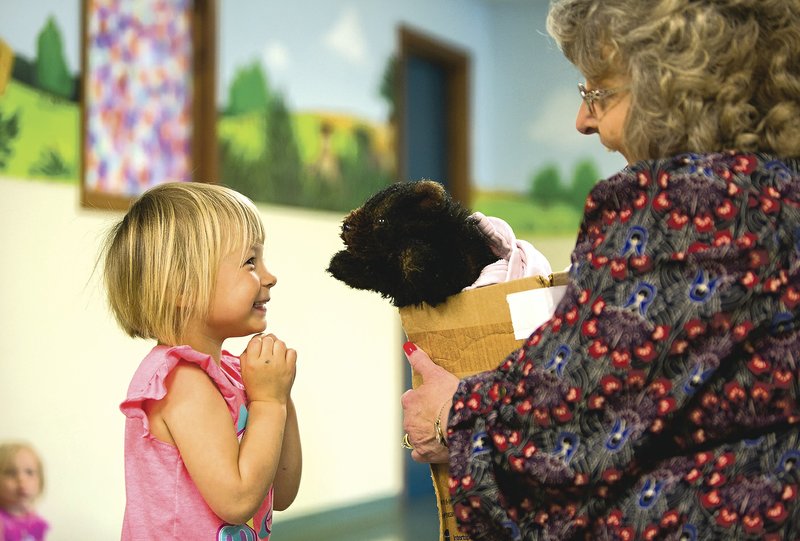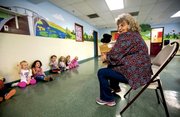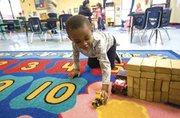Four-year-old Grayson stops in his tracks at the foot of an open child gate at the Helen R. Walton Children's Enrichment Center. Decked out in a Bentonville Fire Department T-shirt, red plastic fireman's hat and holding a stuffed dog tight to his body, he deadpans, "The door should be closed."
"That's right," says Cindy Singleton, 25-year employee and director of the center and Grayson's grandmother. "We close it when there's children here." As Grayson carefully steps into the front office reception area, his toddler brother Carson follows him not two steps behind. Singleton laughs. "And now we have children in here!"
What’s new?
The Walton Children’s Enrichment Center new facility is being designed to include:
• Access to the outdoors from each classroom.
• Places for diaper change on the playground.
• Natural lighting and other sustainable building elements.
• Everything is centered on the children’s needs.
It's shortly after 6 a.m. at the center, but Singleton is chipper, readily greeting each child-parent duo that types in a pin number to enter and drop off their kids before work.
The Walton Children's Enrichment Center is a haven of high quality early childhood care for 242 children ages 6 weeks to 5 years. Started in 1982, it has Better Beginnings accreditation, and through its Early Childhood Initiatives Center, it impacts 30,164 children in the region by training their educators and readying their facilities for state accreditation.
The wait list for the center is an approximate three to five years for hopeful parents, and the infant care wait list is more than 500. Many parents apply to the program before beginning their pregnancy journey.
Despite the honorary name, after the Sam Walton's late wife Helen R. Walton, it's not just a service for executives.
"It's not just a Walmart center," Singleton says. "It's community owned and operated for all children."
With both teacher trainings and child care capacity maxed out, the center has dedicated the next year and a half to fundraising for a new 35,000-square-foot facility and half-acre playground to be built near Crystal Bridges Museum of American Art. Design services, provided through New York based LTL Architects, were made possible by a grant from the Walton Family Foundation.
A "Kickoff to Excellence: Meet the Design Team" community forum discussed the design of the new center at Avondale Chapel in Bentonville Friday. So far, plans include maintaining the same child capacity, roughly 240, but tripling the training center.
ECIC training includes orientation on minimum care for child center licensing, classes on child supervision, nutrition and behavior guidance and resources for teacher classrooms.
"We provide what teachers need to know, without misinterpretation," Singleton says. The classes "reduce the amount of licensing violations" in the state.
The region has 500 early childhood centers, and through help from Walton Children's ECIC, more than half of those have been accredited.
"When we started [ECIC training], 19 percent were accredited ... and now 55 percent are," says Sunny Lane, development manager for the center.
As its longest standing staffer, Singleton stood by the center through its five expansions and continues to provide training to the more than 2,800 visiting early childhood educators because she knows it will have a greater impact than simply caring for more children herself.
That's not to say she doesn't try.
Singleton's day begins at 4 a.m., when she rises to spend an hour of "alone time," usually in prayer. Her husband rises at 5, and the two have coffee before she's off to the center again. When she's not at the center, Singleton says, she's often thinking about it. The first one there, she unlocks the door at 5:45 and welcomes families back just a few minutes after.
On this particular day, smack dab in the middle of Arkansas Children's Week, the center is preparing its tiny constituents for the annual center parade. Each of the 240 children dresses in costume based on the theme "What I want to be when I grow up" and marches in a block around the center with teachers and parents in tow.
Once the madness is done and the children sent back home at the end of the day, Singleton will stick around to teach standards of care to a new round of educators, something she does a few times a month, and likely won't leave until 8:30 p.m.
"I want the best of the best for every child in Northwest Arkansas," Singleton says, noting that they gave her a sign for her office window to indicate when she was out of the office. It's engraved with the rather ambitious end-of-day time of 3 p.m. -- but she hasn't used it much. "It's worth every minute I'm here."
By age 5, a child's brain reaches 90 percent of its adult capacity. That makes Singleton and her crew the driving forces for creating a safe and stimulating environment for children's most critical years of brain development.
Children of this age are "making 700 neural connections per second, no matter what environment they're in," Lane says. That's where "a high quality environment becomes a priority ... [our service] is more than a diaper change."
Children with negative experiences, or without the same level of early childhood education in those years, are more likely to drop out of school eventually, become a teen parent, be placed in special education or never attend college. Approximately 70 percent are more likely to be arrested for a violent crime.
That's why Singleton says she's tough when hiring, especially those who work with 6- and 7-month-olds.
"You have to pass my test to be in infants," she says. "They have stranger anxiety. If you even smell wrong [they won't have it]. It's very important for trust" not just for the baby, but the rest of the family.
"Nobody wants to go to work and worry about their baby [all day]."
According to the Walton Children's Enrichment Center, attendance for even one year in a program like theirs results in "higher kindergarten readiness, higher graduation rates, higher lifetime earnings, lower school remediation, lower need for social services and higher college attendance."
When Singleton began working at the center, she didn't think of its benefits in those specific terms. She just wanted to learn how to be a good mother. She also happened to need a steady job and thought that being a teacher would be the best kind of work.
Raised in a big family that was managed by constant discipline, Singleton relied on what she knew, but she wanted to learn another way to bring up her two children.
"I thought, 'I don't like this, I don't want to be mad and spank my children all the time,'" she says. "I came here to learn how to raise my children and be a good mom, and the glove fit."
Her children grew up alongside her students, and now her grandchildren are growing up alongside her students' children. When parents call, they ask for Cindy by name with the same persistence they save for remaining with the same doctor.
Perhaps they sense that in her 25 years at the center, she's seen a little of everything and experienced a lot within her own family.
In the office, Singleton points out to Grayson that he's wearing two plastic hats and starts to take them off and separate them. "I know," he says impatiently, pulling them back and popping himself in the head with the elastic string. They compromise and put one of the hats on his stuffed "fire dog."
That Cindy has two children and six grandchildren, with another grandchild on the way, is incredibly unexpected. From a young age, doctors told Singleton she couldn't have children. That made her pregnancy with her son quite the surprise, and her pregnancy with her daughter, discovered a short two months after giving birth, an even bigger one.
Her daughter was given the same medical expectations, but after a number of miscarriages, had Grayson. She was pregnant with Carson when Grayson was diagnosed with leukemia. Now he's nearing the end of treatment.
Singleton says she models the level of care at the Walton Children's Center based on what she wants for her very own family. "I firmly believe every experience we have is to help someone else down the road."
NAN Our Town on 04/21/2016


